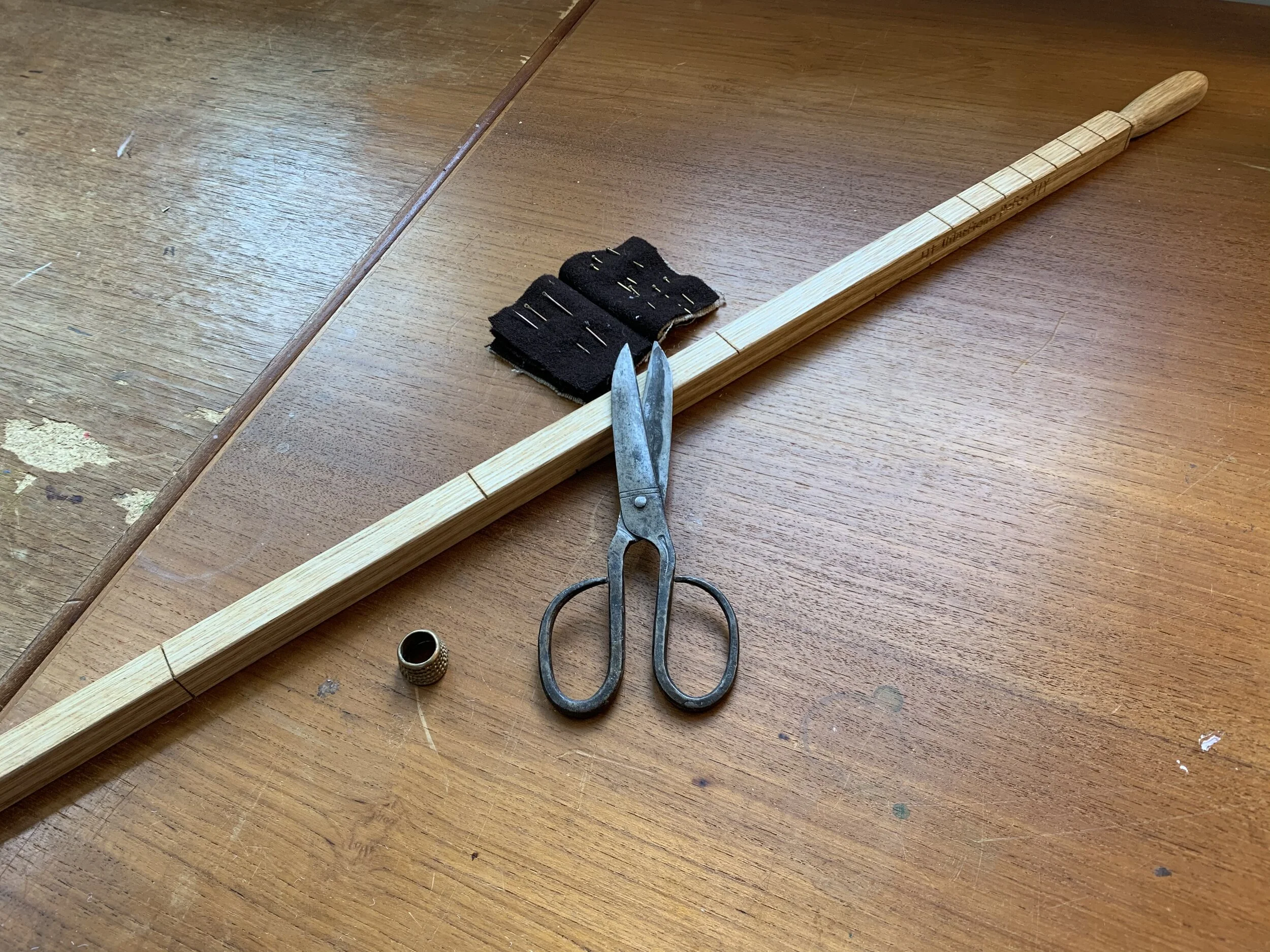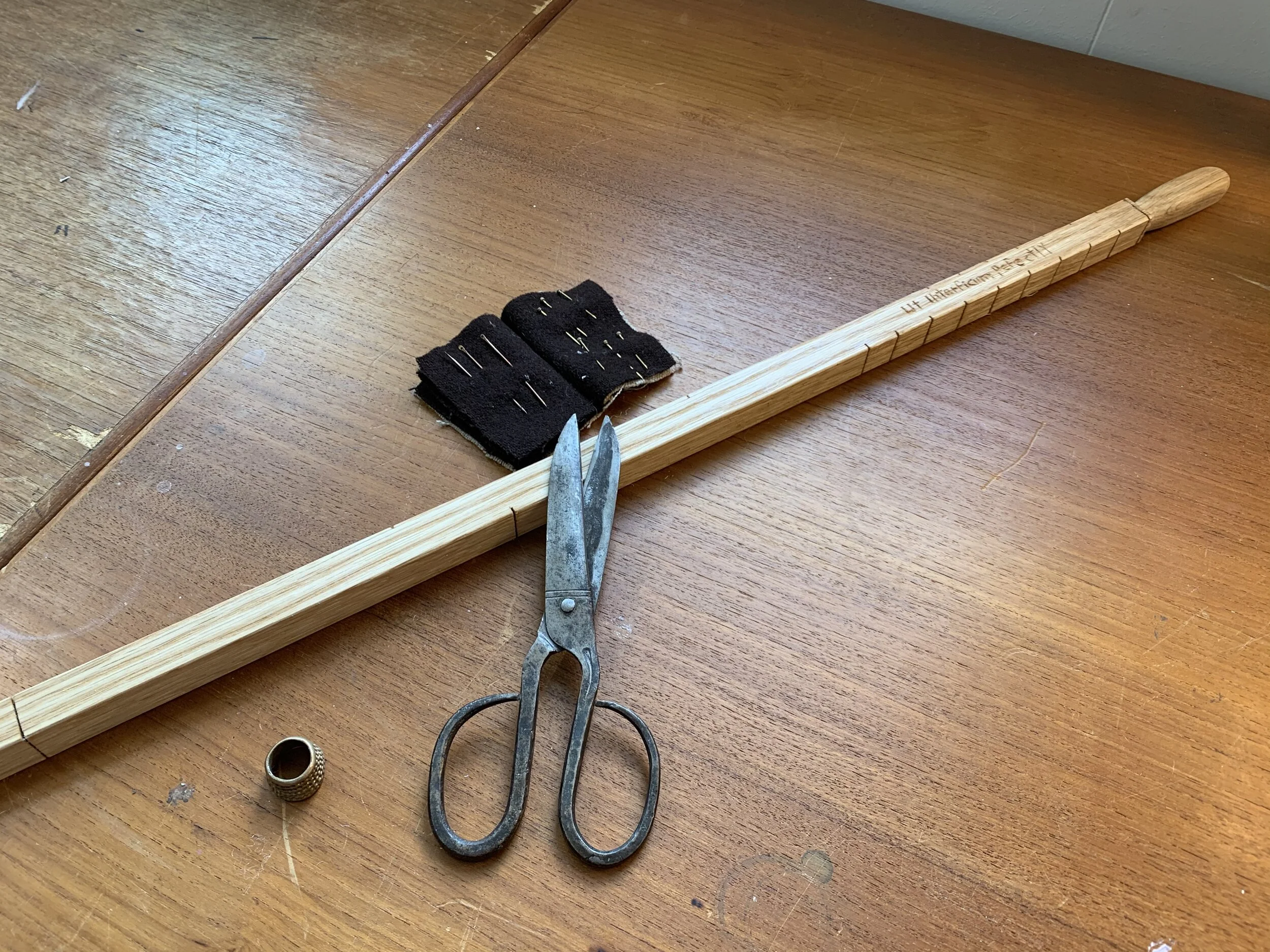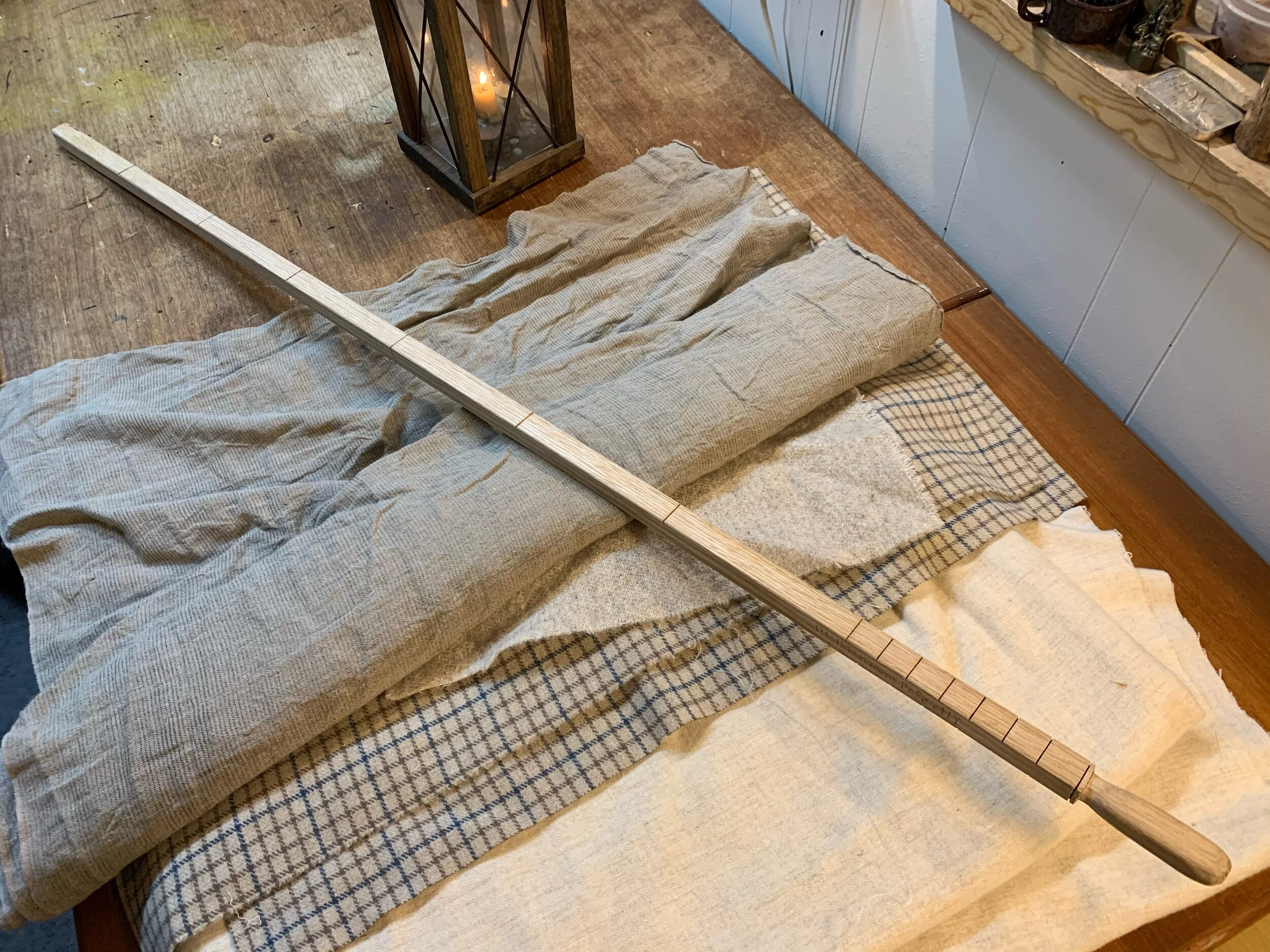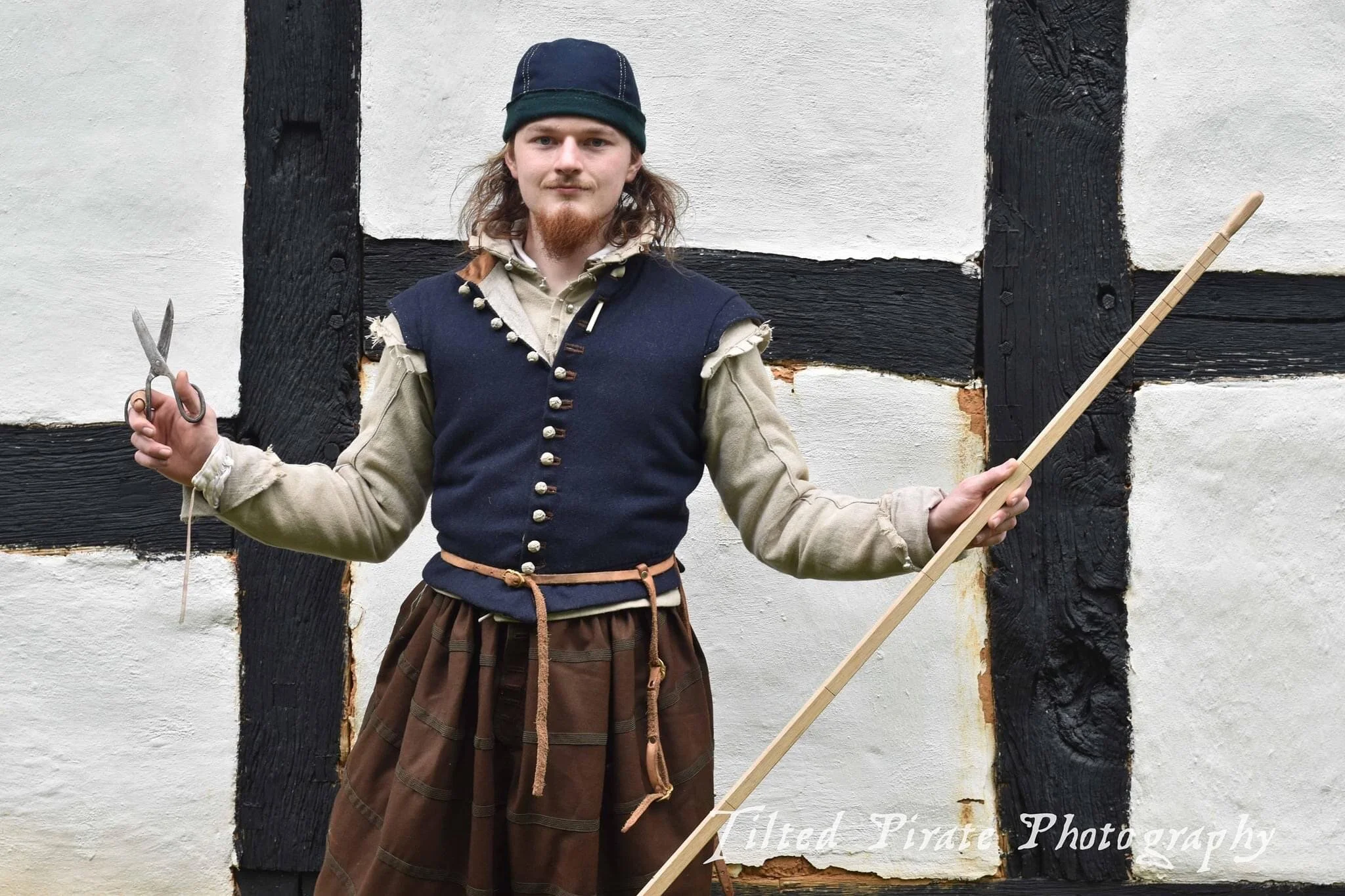when I gave you an inch, you tooke an ell,
:Proverb by by John Heywood in 1546
A short history of the ell wand and how to make your own.
Throughout history tailors and cloth merchants have used string, tape, and parchment to wrap around the bodies of their clients and measure cloth to sell. By the middle ages standard measurements where being used to quantify these strings. By the 14th century the origins of standard linear measure is first mentioned in " The Statute for Measuring Land, 33 Eduard I, Stat. 6, 1305" by Edward I. (1) This document lays out the origins of standardized measurement in England stating “It is ordained that three grains of barley, dry and round, make an inch, twelve inches make a foot, three feet make an ulna” This measure of an ulna would also be called an ell and eventually became the English yard. By the 16th century the ell is distributed and used throughout Europe to measure and deal with cloth. By the time of Queen Elizabeth I the ell and yard had become separated with an ell lengthening to a yard and a quarter or about 45 inches and the yard remaining at 3 feet. (2) Each region had different standards for ells Scottish ell 37 in, the Flemish ell 27 in, the French ell 54 in, the Polish ell 31 in, and the Danish 24 in. Ells had even further variation from town to town.
Brass and Iron ells where produced and mounted at market sites and public spaces so that each town had a standard on which they could base their measurements. Ells like these can be found around Europe and vary in both subdivision and length depending on region. In their book Drei Schnittbucher Katherine Barich and Marion Mcnealy point out that ells where most likely marked in 8ths and 6ths. (3) This is based off of the patterns from the same book which use these subdivisions to draft patterns and measure cloth, as well as the extant metal ells such as the one at the St. Stephen's Cathedral, Vienna, Austria (4). This is divided into 4ths and 3rds and the Leinwandhaus (Museum für komische Kunst), Frankfurter Elle which is divided into 8ths.
Looking to period illustrations of tailors, ell wands (as they are called) can be seen being used on the tailors and cloth merchants cutting table as an active tool in the drafting and measuring process. On the front piece of Geometria traca para el oficio de los sastres by Diego de Freyle, 1588 (above) a tailor can be seen holding an ell wand divided into 3rds and 4ths. in The Kleermaker, by Jan Gillisz. van Vliet, 1635 (below) the tailor cuts his fabric with his ell wand beside him carved with a handle for easy use. Earlier ells seem to lack this feature. ells were possibly used in conjunction with tapes or string to transfer the measurements of a client onto the cloth. This would have been done by holding the tape up to the ell to determine the measure of length.
To build your own English ell wand go to your local hardware store and find a stick of lumber at least (1 x 1 x 45”). I used a stick of ash, and ripped it on a table saw to one inch square. The stick was already 48.5 inches long so I used the remaining 3.5 inches to craft a handle. If making one with a handle buy a stick that is longer than 45”and sculpted it with a small belt sander. This could be achieved by carving with a knife as well. then use a thin hand saw to mark the end near the handle and middle all the way around the stick by making shallow cuts. to do this I used a Japanese pull saw. If making a wand without a handle only carve the middle mark all the way around. Mark 6ths on one side and 8ths on the other. on the section closest to the grip subdivide the 6th and 8th by finger widths. I finished the piece by carving “ut interficiam perfectly” or “To be perfectly cut” in Latin. This is my own personal touch to the piece as it will be a working ell I will use to draft and measure with. To finish the wood give the whole thing a light sand and rub the wood with boiled linseed oil.
Congratulations! you now have your very own ell wand.
Supplies:
Stick at least 1 x 1 x 45”
Table saw (if the stick need to be ripped lengthwise)
Hand saw
Knife or belt sander
high grit sandpaper
boiled linseed oil
Special thanks to: Marion McNealy for advice on the construction and research of this piece.
Bibliography:
The proverbs of John Heywood. Being the "Proverbes" of that author printed 1546. Ed., with notes and introduction". Accessed June 1, 2021. https://archive.org/stream/proverbsofjohnhe00heywrich/proverbsofjohnhe00heywrich_djvu.txt.
Heywood, John, and Julian Sharman. The Proverbs of John Heywood: Being the "Proverbes" of That Author Printed 1546. Norwood Editions, 1978.
Skinner, F. G. “The English Yard and Pound Weight.” Bulletin of the British Society for the History of Science 1, no. 7 (1952): 179–87. https://doi.org/10.1017/s0950563600000646.
Knight, Charles. “The Penny Magazine of the Society for the Diffusion of Useful Knowledge, Volume 9.” Google Books. Charles Knight. Accessed June 1, 2021. https://books.google.com/books/about/The_Penny_Magazine_of_the_Society_for_th.html?id=-BHnAAAAMAAJ.
Barich, Katherine, and Marion McNealy. Essay. In Drei Schnittbücher Three Austrian Master Tailor Books of the 16th Century, 14. Nadel und Faden Press, 2015.
https://commons.wikimedia.org/wiki/File:Wien,_Stephansdom,_Elle_--_2018_--_3297_(cropped).jpg?fbclid=IwAR3CZ0tTWweqxwZHk1lKOuzBwQDKYoullnlayO8H1GmLI1tnl6Zd8hW0F











